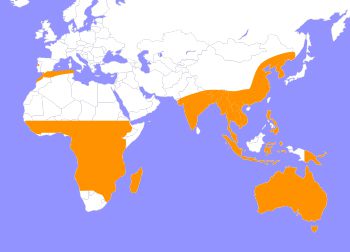Button Quail
Coturnix chinensis
Button quail, also called Bustard Quail, any of numerous small, round-bodied birds belonging to the family Turnicidae of the order Gruiformes. The 15 species are confined to scrubby grasslands in warm regions of the Old World. Button quail are dull-coloured birds, (3 to 7 inches) long, that run crouching and zigzagging through the grass but are capable of weak whirring flight on their short rounded wings. Button quail usually go about singly or in pairs; they may join flocks of true quails.
Females, larger and more strongly patterned than males, do the courting and nest building. Males are much less vocal. They incubate the eggs and care for the young. The females mate with several different males in a single season, running off as soon as the eggs are laid. The incubation period, 12 or 13 days, is the shortest known for any precocial bird. The young are independent within two weeks, undergo two rapid molts, are full sized in six or seven weeks, and may breed when less than three months old.

Button Quails inhabit warm grasslands in Asia, Africa, Europe, and Australia.
HABITAT -They live in grasslands and woodlands of tropical and temperate regions, particularly in the arid and semi-arid areas..
DIET -They are omnivores, they eat both insects and plants.
FUN FACT -Male button quail incubate the eggs and care for the young.
SOCIAL BEHAVIOR -Button quail usually go about singly or in pairs; they may join flocks of true quails.
ACTIVITY -They are diurnal being most active during the day and resting during the evening.
PREDATORS -Predators include birds of prey, snakes and lizards.
SIZE -Button quail vary in size by species, ranging between 3-7 inches long.
RELATIVES -There are many species in the family Turnicidae, including the Quail-plover and Spotted buttonquail.
CONSERVATION -Conservation status varies by species; the Chinese Painted is of Least Concern.
Cub Creek Animal Care Information
Housing - Our button quail can be found in the Small Animal Room. He has a very spacious glass terrarium that gives him plenty of places to roam around. For his comfort, we give him several hides, either plastic or ceramic, that he may choose to hang out in. Because they are such small and fragile birds, he is closed off from being touched, but is very easy to watch with all glass walls. You can even hear him calling sometimes; it’s louder than you would think for such a small bird!
Diet - Like many of our other birds here, Barney is fed game bird finisher. This crumble contains everything he needs to be healthy and active. Birds are very good at not over eating, so he is given as much as he wants. There is also a water bowl in his enclosure so he always has access to fresh water.
Enrichment - He is a very nervous bird, so he does not get enrichment through interaction. Rather, our interns will add new hides or rearrange his enclosure so he has new places to explore. These new features can be made out of cardboard, plastic, or really anything you can think of!

